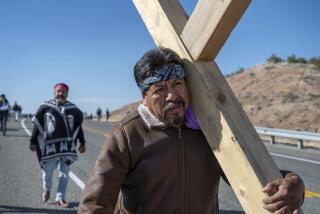Swallows Day Celebration Takes on New Meaning
- Share via
News travels far. And myths do, too.
It seemed not too long ago that I was a student in a high school geography class in Trinidad and Tobago, a tiny twin-island nation in the southern Caribbean. The topic was North America. The only thing I can remember from that class is my teacher saying that he had heard about a startling phenomenon that takes place in California: On the same day every year, swallows return from South America to “this Catholic mission.”
Last week, as a reporter I had a chance to find out for myself about the fabled return of the birds to that Catholic mission.
I don’t think that I ever really believed that the swallows arrived in San Juan Capistrano--at the Roman Catholic church built by Spanish missionaries--exactly on March 19, which is St. Joseph’s Day.
And I doubted that others believed the fable--until I covered Swallows Day this month. By 7:45 a.m. when I got there, the mission grounds were already teeming with tourists from around the country.
It was easy to tell them from the locals. As the 8 a.m. hour approached, one excited woman ran up to a group of docents and asked: “Is there a special spot in the mission where the swallows land?”
A docent couldn’t help but shoot back: “There is, but that landing place is closed today.”
Shortly thereafter, Paul Arbiso, the city’s patriarch, rang the bells to signify that the first swallow had been sighted.
Donna Eberhart-Phillips, of La Canada Flintridge in Los Angeles County, was puzzled. She had promised her 4-year-old son, Luke, that she was taking him to see “thousands of birds.”
The problem was that after Arbiso sounded the bells, she and Luke looked up only to see a few pigeons flutter away.
Dorothy O’Quinn was even more crestfallen. Long after Arbiso sounded the bells, O’Quinn remained in the courtyard wondering if she had missed the birds.
It turned out that O’Quinn, 81, a retired teacher from San Bernardino, had waited 30 years to attend the event.
She too expected a scene resembling one from Alfred Hitchcock’s “The Birds.”
I was amused by the entire situation but remained curious to learn exactly how this tradition began. And what I found out confirmed the suspicions I had nursed at home in the Caribbean.
At the same time, I learned that Swallows Day is a tradition that also binds the Juaneno Indians, the first inhabitants of the San Juan Capistrano area.
County historian Jim Sleeper traces the myth of the swallows’ return to Father John O’Sullivan, who was the priest of the mission from 1910 to 1933.
Sleeper said that on O’Sullivan’s birthday in 1911--which happened to be St. Joseph’s Day--the priest was feeling glum until a flock of swallows arrived. And, he said with a chuckle, they continued to arrive on the same date every year since 1911.
But why, I wanted to know, is the return of the swallows celebrated only at Mission San Juan Capistrano?
Swallows also nest in the missions in San Luis Rey, Santa Barbara and San Gabriel, though not in the same numbers as they did at the turn of the century.
The difference, it seems, was Leon Rene, the singer-songwriter who gave us “Rockin’ Robin.” Rene’s other contribution to music came in the 1930s after he heard a radio report about the swallows returning to San Juan Capistrano.
Rene immediately put pen to paper and came up with “When the Swallows Come Back to Capistrano,” which has been heard around the globe since 1939, according to the songwriter’s son, Raphael.
The song remains a hit. Some older couples at the festival held hands and swayed as Raphael Rene sang his father’s song.
The wistful look on one woman’s face set me thinking. The myth has provided a sense of place and tradition for San Juan Capistrano, but I thought that there is more meaning to Swallows Day than the tourists who flock to the mission in larger numbers than the birds.
I realized that the Juaneno Indians, who come to the celebration every year, don’t come expecting to see swallows, but to continue the traditions of their ancestors, who labored to build the mission and who survived generations of oppression, sometimes at the hands of the the missions’ priests.
This year, for the first time in the 216-year history of the mission, the Juanenos were allowed by the church to conduct a portion of the official St. Joseph’s Day Mass in the language of their ancestors.
The Juanenos that I interviewed told me that they were ecstatic about this. The mission is a tourist stop and generates revenue for the city, but it is holy ground for the Juanenos.
The day before the celebration, David Belardes, chairman of the Tribal Council of the Juaneno Band, broke down in tears after another tribal member related how Belardes’ mother, though poor, would save her pennies in a jar and take it over to the mission to help pay for its upkeep.
“All our secrets are stored in this place,” said Jerry Nieblas, a Juaneno and a mission employee. “We have to preserve it. We walk with our ancestors whenever we walk here.”
I was struck because the Juanenos did not seem bitter, but grateful that the church decided to acknowledge their contribution by including their language in the Mass--even though it took centuries for this recognition.
I still didn’t see a swallow on Swallows Day.
But it didn’t really matter.
More to Read
Sign up for The Wild
We’ll help you find the best places to hike, bike and run, as well as the perfect silent spots for meditation and yoga.
You may occasionally receive promotional content from the Los Angeles Times.






